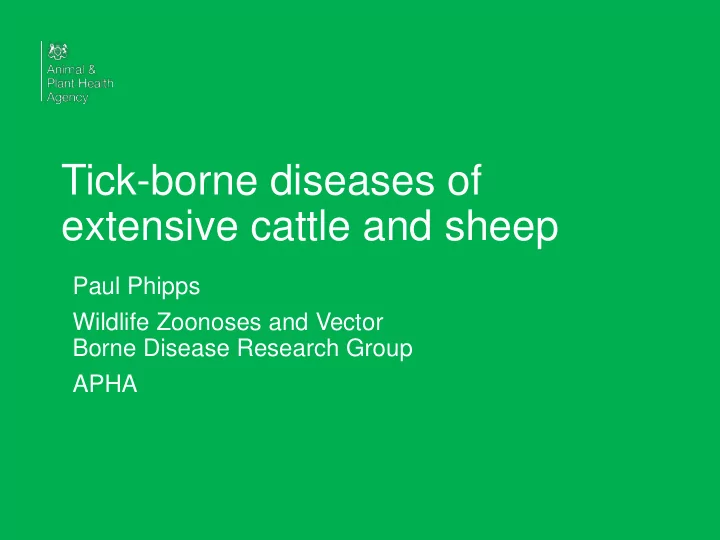

Tick-borne diseases of extensive cattle and sheep Paul Phipps Wildlife Zoonoses and Vector Borne Disease Research Group APHA
Ticks as disease vectors Phylum: Arthropoda, Class: Arachnida, Order: Parasitiformes Three families: Argasidae (Soft ticks), Ixodidae (Hard ticks ), Nutelliedae (1 sp) 3 genera ( Ixodes , Haemaphysalis , Dermacentor ) described from UK • Ticks may feed on multiple hosts during their life cycle • Ticks secrete salivary fluid on attachment which is proteolytic, immunomodulatory. • Tick borne pathogens transmitted in salivary fluid during feeding Diseases transmitted to animals in UK • Protozoa - babesiosis, theileriosis, • Bacteria – Tick borne fever, Lyme borreliosis. • Virus - Louping Ill
Ixodes ricinus (sheep, deer, castor bean tick) • All feeding stages Life cycle hatch in late Larva. Small and large Egg. (Ca 2000 per clutch) summer/autumn mammals and birds • Host seeking peaks in spring and late summer/autumn • Ticks unable to find host in Autumn seek host in following spring • Ca 3 years to complete life cycle (only 20 days feeding on host) • I. ricinus requires rH ca 90% to survive off Adult . Large Nymph. Small, large host. mammals mammals and birds
Babesia sp. infecting cattle in UK B. divergens (Redwater Fever) • Intra-erythrocytic protozoan parasite • B. divergens transmitted by I. ricinus • B.major transmitted by Haemaphysalis punctata. • Infection picked up by feeding female tick – transovarial transmission to B. major (non pathogenic ??) larva via egg then transtadially to nymph and adult • Infection via sporozoites in the salivary fluid of feeding tick
Signs and symptoms of clinical babesiosis • Increased temperature (>40C) Haemolytic anaemia following B. divergens infection • Pipe stem diarrhoea may be followed by constipation • Hammer pulse (visually evident) • Respiratory distress • Haemoglobinuria (port wine red urine due rupture of the rbcs) • Anaemia • Abortion in pregnant cows • Death (although rare in UK cattle) • Premunity following recovery (carrier state) Endemic Stability = Low level of disease Calves below 6months resistant to disease Colostral Ab from carrier dams Continued tick challenge
Tick borne fever: Anaplasma phagocytophilum • Transmitted by I.ricinus , in UK. A.phagocytophilum in bovine neutrophil • Symptoms include high fever >40C, severe loss in milk production • Infects neutrophils, eosinophils and later monocytes. • Immunosupressive - may lead to Tick pyaemia, pasteurellosis, septicaemic listeriosis, louping ill. • Abortion storms in naive animals.
Louping Ill A Flavivirus, Limited geographical distribution Causes acute encephalomyelitis in sheep Vaccine available for veterinary use Other domestic animals and wildlife affected Transmitted by Ixodes ricinus ticks Louping ill in the UK (2007) Species Number of cases Sheep ( Ovis aries ) 31 Cattle ( Bos taurus ) 12 Red grouse 67 ( Lagopus lagopus scoticus ) Hare ( Lepus 17 timidus )
Theileriosis of cattle and sheep Ovine Theileria sp in sheep rbc • Transmitted by Haemaphysalis punctata ticks (Coastal habitats in South East and West Wales) Cattle • T. mutans described by Brocklesby et al 1972 . Low pathogenicity. Sheep • T. ovis – Lewis & Purnell 1981 (Ogmore, South Wales) • T. recondita – Alani and Herbert 1988 (Lleyn Theileria sp schizont in lymphocyte peninsular, North wales) • Low pathogenicity However……..
Ovine theileriosis UK Phipps et al. (2016) Detection of Theileria luwenshuni in sheep from Great Britain. Parasites & Vectors 9:203 • April 2005 mortality associated with heavy infestations of H. punctata . • 60 ewes and their lambs grazing north Kent marshland 25 deaths . • PM revealed: Oedema of lips, tongue, lungs, froth in trachea. Spleen enlarged, kidneys pale, anaemia. • Anaplasmoid inclusions in Giemsa stained blood smears • No disease reported since 2012 • 21 blood samples collected from sheep grazing same pastures • 16/21 positive by pan-piroplasm PCR, sequencing revealed T. luwenshuni . • Same parasite reported as pathogenic in China and transmitted by Haemaphysalis sp. (Yin et al 2007) • Is this T. ovis/T recondita previously reported in the 1980s ?
Bovine theileriosis UK • Brugman et al (2015) Parasites and Vectors, 8(421), 1-8 Molecular species detection, host preferences and detection of Myxoma virus in the Anopheles maculopennis complex in Southern England. • Xenodiagnosis of viral disease in mosquitoes collected from Elmleigh Marshes, Isle of Sheppey. • Blood meal analysis showed that A. atroparvus and C. annulata (mosquitoes) both fed on cattle • Theileria orientalis detected by pan- piroplasm PCR and sequencing – a strain of the organism currently causing well publicised disease outbreaks in NZ and Australia • Is this the T. mutans described by Brockelsby et al in 1972?
Thank you for your attention! Paul Phipps, Wildlife Zoonoses and Vector Borne Disease Research Group, Virology Dept APHA.
Recommend
More recommend